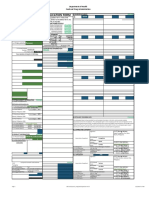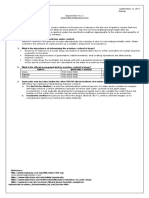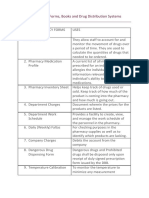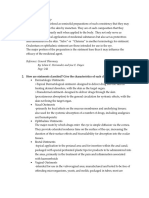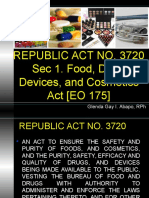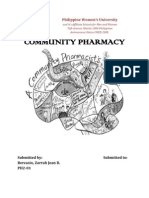INTERN 3 - Internship III (Manufacturing Pharmacy)
INTERN 3 - Internship III (Manufacturing Pharmacy)
Uploaded by
Princess Sittie Asiah AbdullahCopyright:
Available Formats
INTERN 3 - Internship III (Manufacturing Pharmacy)
INTERN 3 - Internship III (Manufacturing Pharmacy)
Uploaded by
Princess Sittie Asiah AbdullahCopyright
Available Formats
Share this document
Did you find this document useful?
Is this content inappropriate?
Copyright:
Available Formats
INTERN 3 - Internship III (Manufacturing Pharmacy)
INTERN 3 - Internship III (Manufacturing Pharmacy)
Uploaded by
Princess Sittie Asiah AbdullahCopyright:
Available Formats
Syllabus for Internship III S.Y.
2011-2012 Course Title Course Number Credit Units Pre requisite : INTERNSHIP III : INTERN III : 2 units, 4th year 1st semester : Phar 6 and Manufacturing Pharmacy internship (200 hours)
Course Description : A study and analysis on the basic manufacturing processes, facilities design issues, validation and regulatory affairs concepts which drive the manufacturing industry. Focuses on cGMP, drug product development regulatory & registration requirements, and different unit operations & manufacture of pharmaceutical products. Students are expected to design pharmaceutical plant and product formulation in accordance with the cGMP. Major Competency : The beginning Thomasian pharmacist understands the core concepts of quality and develops skills in identifying, compounding and dispensing, manufacturing, and storing drugs and apply these concepts and skills in the preparation of drug products. General Objectives : 1. Associate the different provisions of the current Good Manufacturing Practice with the organizational set-up, equipment, facilities, and activities in a pharmaceutical manufacturing firm. 2. Establish the regulatory requirements and guidelines on labeling in accordance with BFAD Course Outline : Monthly Grading Period Specific Objectives Content UNIT I PHARMACEUTICAL MANUFACTURING State the mission vision of the company Identify the major activities in the company to carry out their mission vision Classify the company as a drug establishment Highlight the key learning of the student during the internship period Exercise no. 1 The Pharmaceutical Manufacturing company and Summary of Key Learnings and Experience Cognitive apprenticeship Product assessment 2 hours Teaching Strategies Evaluation Tool Time Allotment
Specific Objectives
Content
Teaching Strategies Metacognitive
Evaluation Tool Product assessment
Time Allotment 2 hours
Present the organizational set-up of the company Identify the gap between the organizational set-up and cGMP basic guidelines on personnel Identify the qualifications, basic functions and responsibilities of the production manager and quality manager State the training programs of the company for the personnel Describe the sanitation and hygiene program/practice of the company and compare with cGMP Illustrate the location and construction of the manufacturing building of the company Share and Learn from other interns about their observations and be able to present an appropriate lay-out of the major areas in the company Relate the location, construction, design and lay-out of the building to section 2 & 3 of the cGMP guidelines
Exercise no. 2 - The Personnel
Exercise no. 3 The Premises and Equipment
metacognitive
Product assessment/ Mastery test
4 hours
UNIT II DRUG PRODUCT Gain comprehensive understanding on the activities involved in the receipt and storage of materials Identify key activities and documents needed when receiving and storage of materials Emphasize the importance and criticality of the activities involved in receiving and storage of materials Exercise no. 4 Receipt and Storage of Materials in the Warehouse Cognitive apprenticeship Product assessment, mastery test 4 hours
Preliminary Grading Period Specific Objectives Content Teaching Strategies Simulation strategy Evaluation Tool Product assessment Time Allotment 4 hours
Present all the processing steps involved Exercise no. 5 Production in the manufacture of drug products in different dosage forms Identify the in-process quality control (IPQC) tests done when producing drug products Stress the importance of documentation in every step of the process Relate the productions steps as learned from the internship program and from previous course Phar 3 and Phar 6 Stress the importance of cGMP in assuring quality of drug products Establish the different activities in packaging of drug products Recognize the IPQC tests done when packaging drug products Ascertain the compliance of the company with cGMP requirements in packaging drug products Gain comprehensive understanding on the activities involved prior to the distribution of the drug product to the market Identify key activities and documents needed generated during finished product quarantine and delivery to the warehouse Emphasize the importance and criticality of the activities involved in finished product quarantine and delivery to the warehouse Exercise no. 6 Packaging of Drug Products
Metacognitive
Product assessment, mastery test
2 hours
Exercise no. 7- Finished Product Quarantine and Delivery to the Warehouse
Simulation strategy
Product assessment
2 hours
Specific Objectives Determine the official pharmacopoeia specifications for the microbiological and quality of pharmaceutical products Evaluate the methods of counting microorganisms in pharmaceutical products Demonstrate the procedure recommended by the official pharmacopoeia in testing specific microorganisms Classify sterility test Differentiate the official tests in detecting and measuring pyrogens
Content Exercise no. 8 Microbiological Quality of Pharmaceutical Materials
Teaching Strategies Metacognitive
Evaluation Tool Product assessment, mastery test
Time Allotment 4 hours
Final Grading Period Specific Objectives Content UNIT III REGULATORY AFFAIRS Recognize the licenses required for Exercise no. 9A - Registration of a Drug pharmaceutical manufacturing laboratory Establishment to operate Determine the step by step procedure in the application for a LTO Determine the general and additional requirements needed for the licensing of a pharmaceutical manufacturing laboratory Evaluate the existing laws which affect the operation of the pharmaceutical manufacturing laboratory Recognize manufacturers which comply with the cGMP set by the FDA Metacognitive Product assessment 2 hours Teaching Strategies Evaluation Tool Time Allotment
Specific Objectives Determine the step by step procedure in product registration application Recognize the general and additional requirements for product registration application Recognize the laws affecting the application of product registration
Content Exercise no. 9B- Registration of a Drug Product
Teaching Strategies Metacognitive
Evaluation Tool Product assessment, mastery test
Time Allotment 2 hours
UNIT IV RESEARCH AND DEVELOPMENT Determine the importance of postmarketing surveillance of pharmaceutical products Evaluate the persons qualified for the post-marketing surveillance Demonstrate the procedure in conducting post-marketing surveys Demonstrate the steps that must be done on returned drug products Identify the conditions when to salvage the returned drug products or not Determine the steps must be done on drug products that are not salvaged Demonstrate the steps that must be done on salvage drug products Classify the drug product developed by the company Identify the activities involved in drug product development Determine the documents that can be generated from the a drug product development Exercise no. 10 Post-Marketing Surveillance of Pharmaceutical Products Metacognitive Product assessment 3 hours
Exercise no. 11 Returned and Salvaged Drug Products
Peer Mediating
Product assessment
2 hours
Exercise no. 12 Drug Product Development
Interactive lecture
Product assessment, mastery test
3 hours
Course References:
Pharmaceutics: The Science of Dosage Forms Design, 2nd Edition Ansels Pharmaceutical Dosage Forms and Drug Delivery Systems, 9th Edition The Theory and Practice of Industrial Pharmacy, 1986 Remington Pharmaceutical Sciences, 21st Edition Pharmaceutical Codex, 12th Edition United States Pharmacopoeial/National Formulary, Latest Edition FDA Current Good Manufacturing Practice Guidelines FDA Guidelines on Labeling of Drug Products and Drug Establishments
Grading System: Grading Period Monthly Preliminary Final Periodical Examination 40% 40% 30% Quizzes 30% 30% 30% Exercises (including reports) 30% 30% 30% Internship (Evaluation Grade) Total 100% 100% 100% Breakdown 33.33% 33.33% 33.33%
10%
Course Policy:
At least with an 80% attendance Passing rate: 75%
Prepared by:
Marilyn A. Ngo, M.S. Phar James N. Pasamonte, M.M. May 2011
Date:
Approved by:
Prof. Priscilla M. Torres, PhD Dean, UST Faculty of Pharmacy
You might also like
- Act 1 Manamparan Hosny M.Document8 pagesAct 1 Manamparan Hosny M.Gizelle Mae Pasiol-Macayan100% (3)
- Administrative Order No 56 S 1989Document7 pagesAdministrative Order No 56 S 1989Anne Marion Perez75% (4)
- Unit 9 - Patient Medication ProfileDocument33 pagesUnit 9 - Patient Medication ProfileMark Angelo JaurigueNo ratings yet
- Choral Speaking PharmacyDocument3 pagesChoral Speaking PharmacyNUR ANIS ATIQAH BINTI YAHYA MoeNo ratings yet
- Damasco - Cpi - Activity No.9Document5 pagesDamasco - Cpi - Activity No.9LDCU - Damasco, Erge Iris M.No ratings yet
- Quality Control Answer Key-RED PACOPDocument26 pagesQuality Control Answer Key-RED PACOPMelbhon Fabro RamosNo ratings yet
- cGMP Current Good Manufacturing Practices for PharmaceuticalsFrom EverandcGMP Current Good Manufacturing Practices for PharmaceuticalsRating: 1 out of 5 stars1/5 (2)
- CRO and Sponsor - Integrated Application FormDocument4 pagesCRO and Sponsor - Integrated Application FormNaevisweloveuNo ratings yet
- White LabelDocument1 pageWhite LabelDee BelarminoNo ratings yet
- Generic Menu CardDocument9 pagesGeneric Menu CardLode DeocadesNo ratings yet
- Primary Sop SCMDocument7 pagesPrimary Sop SCMKapil Kumar SS100% (1)
- A.O 64 S. 1989Document14 pagesA.O 64 S. 1989Kitkat CasacopNo ratings yet
- AO 2016 0008 Revised Labeling PresentationDocument120 pagesAO 2016 0008 Revised Labeling PresentationRaeanne Sabado100% (2)
- PHA6111 Lab ACTIVITY 2 HERNANDEZDocument4 pagesPHA6111 Lab ACTIVITY 2 HERNANDEZGrace HernandezNo ratings yet
- Exp 2Document1 pageExp 2Janice Malafu De GuiaNo ratings yet
- Activity No 3,4,10Document9 pagesActivity No 3,4,10Christian Rey Abuan80% (10)
- Pharmaceutical Dosage FormsDocument10 pagesPharmaceutical Dosage FormsprinceamitNo ratings yet
- Medication Review (Examples of Forms For Documenting Medication Review)Document4 pagesMedication Review (Examples of Forms For Documenting Medication Review)Sophia AndresNo ratings yet
- Malpratice JournalDocument5 pagesMalpratice Journalmeong_rj12_427495538No ratings yet
- Medspan's Pharmacy Guide For OSCEDocument8 pagesMedspan's Pharmacy Guide For OSCEDeviselvam100% (1)
- Biopharmaceutics VIOLET PACOPDocument35 pagesBiopharmaceutics VIOLET PACOPLilian Daria100% (9)
- Weight Variation Test of Capsules Using Statistical Quality ControlDocument6 pagesWeight Variation Test of Capsules Using Statistical Quality ControlRaisa Louise Gamiao TattaoNo ratings yet
- Ao 99 S 1990Document2 pagesAo 99 S 1990taengoo2180% (1)
- Ra 9711Document15 pagesRa 9711Johnny ManahanNo ratings yet
- Brex Manufacturing EditedDocument291 pagesBrex Manufacturing EditedMing MingNo ratings yet
- Activity #3Document9 pagesActivity #3PrincessNo ratings yet
- Drug Approval System of The Philippines PDFDocument56 pagesDrug Approval System of The Philippines PDFPatrick OribelloNo ratings yet
- 1 - DS SATK Form - Initial Application of LTO 1.2Document4 pages1 - DS SATK Form - Initial Application of LTO 1.2cheska yahniiNo ratings yet
- Hospital Pharmacy Forms, Books and Drug Distribution SystemsDocument8 pagesHospital Pharmacy Forms, Books and Drug Distribution SystemsMariel AfuangNo ratings yet
- Cold Cream USPDocument4 pagesCold Cream USPRon OlegarioNo ratings yet
- Generics Act of 1988Document5 pagesGenerics Act of 1988JIEZFANo ratings yet
- RA 5921 and RA 10918Document32 pagesRA 5921 and RA 10918Hani Loveres100% (1)
- Ra 3720 - Safety and Purity of Foods, and CosmeticsDocument70 pagesRa 3720 - Safety and Purity of Foods, and CosmeticsShehana Tawasil MusahariNo ratings yet
- Dr. Nelson T. TubonDocument29 pagesDr. Nelson T. TubonBS50% (2)
- APPGP MFG OC G4 PD UNIT DOSE AND BATCH FORMULATIONDocument5 pagesAPPGP MFG OC G4 PD UNIT DOSE AND BATCH FORMULATIONIsabel PeraltaNo ratings yet
- Exercises 8-10 (By Dr. N. Tubon) PDFDocument25 pagesExercises 8-10 (By Dr. N. Tubon) PDFLoren100% (1)
- Hospital FormularyDocument27 pagesHospital FormularyMarvin BernalesNo ratings yet
- Pharmacy PDFDocument25 pagesPharmacy PDFSauraj GautamNo ratings yet
- MFRDocument3 pagesMFRAlok Kumar100% (1)
- PH Chem 1Document10 pagesPH Chem 1Starlyn Jonalee Amarillo Alger50% (2)
- Pharmaceutical Jurisprudence and Ethics ManualDocument41 pagesPharmaceutical Jurisprudence and Ethics ManualMeg Gutierrez75% (16)
- Compounding ExtemperaneousDocument48 pagesCompounding Extemperaneousedunation024No ratings yet
- USP-NF Deliverable VolumeDocument4 pagesUSP-NF Deliverable VolumeNguyen Hai YenNo ratings yet
- PH-PHR212 Lecture 2 FS2021 PDFDocument57 pagesPH-PHR212 Lecture 2 FS2021 PDFIra MoranteNo ratings yet
- Isotonic and Buffer SolutionsDocument63 pagesIsotonic and Buffer SolutionsShailu Gracie BalacuitNo ratings yet
- REPUBLIC ACT No 10918 Sec. 1-5Document10 pagesREPUBLIC ACT No 10918 Sec. 1-5Ralph Aubrey CulhiNo ratings yet
- DISPLABPreps1 20 2Document21 pagesDISPLABPreps1 20 2Alexa Joy C. InguilloNo ratings yet
- Philippine Standard Practice For PharmacistDocument8 pagesPhilippine Standard Practice For PharmacistLoise100% (1)
- Power Failure Contingency PlanDocument2 pagesPower Failure Contingency PlanDaniel Yves IV Paez100% (2)
- Chapter 16 - Reducing and Enlarging Formulas StudentDocument28 pagesChapter 16 - Reducing and Enlarging Formulas StudentKatie Wilson100% (4)
- The Philippine Pharmacy Act: RA 10918 Submitted By: Emerald Shaine P. SamozaDocument49 pagesThe Philippine Pharmacy Act: RA 10918 Submitted By: Emerald Shaine P. Samozaemerald shaine samozaNo ratings yet
- Institutional Pharmacy PracticeDocument17 pagesInstitutional Pharmacy PracticeRichmond AmuraoNo ratings yet
- Stability StudiesDocument34 pagesStability StudiesJheann Del RioNo ratings yet
- FDA PresentationDocument27 pagesFDA PresentationTimothy William C. Laurence100% (1)
- Deliverable VolumeDocument3 pagesDeliverable VolumePrince MoniNo ratings yet
- Solution, Solubility and Factors Affecting SolubilityDocument6 pagesSolution, Solubility and Factors Affecting Solubilityshehryar khanNo ratings yet
- Integrated Application Form (97-2003 Compatible)Document15 pagesIntegrated Application Form (97-2003 Compatible)Carmen Yalung Garcia56% (9)
- CMCK ActDocument96 pagesCMCK ActCrizza Mae Chua KimNo ratings yet
- PH 107 DDS Lab Midterm NotesDocument11 pagesPH 107 DDS Lab Midterm NotesKrsna NaveraNo ratings yet
- Ra 10918 PDFDocument19 pagesRa 10918 PDFJohn Fritz Gerald BascoNo ratings yet
- Community Pharmacy InternshipDocument11 pagesCommunity Pharmacy InternshipZarrah Jean Bercasio-Muñoz100% (9)
- Chief Pharmacist RefDocument4 pagesChief Pharmacist RefMOUREENNo ratings yet
- Golongan Antifungal Antifungal Drug Waktu ParuhDocument1 pageGolongan Antifungal Antifungal Drug Waktu ParuhbertouwNo ratings yet
- 70-Article Text-286-2-10-20221205Document7 pages70-Article Text-286-2-10-20221205Nurul Maulida PutriNo ratings yet
- Support RuralDocument70 pagesSupport RuralNguyen TranNo ratings yet
- Drugs in The ElderlyDocument38 pagesDrugs in The ElderlyMyda Efron ArchuletaNo ratings yet
- Wimits NewDocument1 pageWimits NewaoryaNo ratings yet
- Mix So Des 2021Document299 pagesMix So Des 2021Rizki SNo ratings yet
- ICH Guidelines IndexDocument5 pagesICH Guidelines Indexyashpandya01No ratings yet
- JD Pharmacy Manager Supply Chain Financial ServicesDocument6 pagesJD Pharmacy Manager Supply Chain Financial ServicesBhavikaNo ratings yet
- A Magyar Gyógyszerésztudományi Társaság Lapja: A Tar Ta Lom BólDocument68 pagesA Magyar Gyógyszerésztudományi Társaság Lapja: A Tar Ta Lom BólAyna AynaNo ratings yet
- Prescription Pad Template GuideDocument4 pagesPrescription Pad Template Guidesolomon johnNo ratings yet
- Pharmacists Board Exam Results For June 2009Document19 pagesPharmacists Board Exam Results For June 2009Erwin Ampoloquio100% (2)
- Medication CounselingDocument20 pagesMedication CounselingClaire Marie AlvaranNo ratings yet
- Degree - Us - 12 - 13072020Document221 pagesDegree - Us - 12 - 13072020Krishna Chaitanya ChowdaryNo ratings yet
- JNTUK JUMBLING CENTRES LIST December 2023Document6 pagesJNTUK JUMBLING CENTRES LIST December 2023kailash0% (1)
- OtcDocument10 pagesOtcJames PerianayagamNo ratings yet
- Phenytoin Administration GuideDocument3 pagesPhenytoin Administration GuideWomen 68No ratings yet
- Evaluating ExamDocument733 pagesEvaluating ExamLee Wai LeongNo ratings yet
- MAPP 5016.6 - Change in Hard Gelatin Capsule SupplierDocument2 pagesMAPP 5016.6 - Change in Hard Gelatin Capsule Suppliermaneshdixit4312No ratings yet
- Medication AdministrationDocument134 pagesMedication Administrationaryanmohamad210No ratings yet
- Aadee RemediesDocument1 pageAadee RemediesRussell PeterNo ratings yet
- Herbals and BreastfeedingDocument8 pagesHerbals and BreastfeedingArshad SyahaliNo ratings yet
- Elliott GorelickDocument2 pagesElliott GorelickMichele Marcucci EllsonNo ratings yet
- Daftar Obat Paten Update 16 Juni 2023Document3 pagesDaftar Obat Paten Update 16 Juni 2023Arsiaty SumuleNo ratings yet
- Clearwater TribuneDocument6 pagesClearwater TribunewestribNo ratings yet
- Mcqs - Pharmacodynamics & Pharmacokinetics May 2006Document5 pagesMcqs - Pharmacodynamics & Pharmacokinetics May 2006Miguel LigasNo ratings yet







